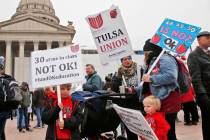Much to do about speed bumps
Q: I live in a condominium community that has a homeowners association. Some time ago, one of our owners complained to the fire department that a delivery truck was double-parked and blocking his car.
This brought the fire inspector down and we were ordered to remove all speed bumps, mark all red curbs for fire lanes and replace our no-parking signs with fire lane signs that warn vehicles not to park there or risk being towed.
We have 244 units and limited money. We already completed the first part of the project by marking the fire lane areas. We received an extension for completing the speed bumps before fines. This will be very costly. Although we were told the bumps slow emergency vehicles in time of need, removing them can cause emergencies by inviting speeding by ordinary drivers.
Is there a new law requiring communities to remove speed bumps? Can we use our reserve fund to finance this?
A: Different departments (Clark County, Las Vegas, Henderson and North Las Vegas) have different policies for enforcing the codes.
Clark County’s website states, “Clark County does not use or allow speed humps/bumps on public maintained roadways within the unincorporated areas of Clark County.”
Traffic-calming devices that have not been approved with a plan and permit are illegal in Las Vegas. This pertains to all property types, including shopping centers, business buildings and apartment complexes. Anything that alters emergency response to a location, including traffic-calming devices, temporary barricades for parking lot resurfacing or trenching work, or installations that affect fire lanes, requires approval before it can be built.
The city of Las Vegas’ website states, “Unless chronic speeding problems exist on your street, speed humps are not warranted.”
A residential street will qualify for the city’s speed hump program if meets it following criteria:
1. It accommodates 800 vehicles a day as required; 2. the two-lane street must be mainly residential or else have a park or school on the street; 3. the speed limit must be 25 miles per hour; 4. there may not be any regional transit bus routes on the street; 5. the street cannot be designated emergency response route.
The Southern Nevada Fire Code, section 503.4.1, “Speed bumps and speed humps,” says the devices “shall not be permitted within the required width of fire apparatus access roads.
“Exception: Speed humps are allowed on private fire apparatus access roads serving commercial and industrial buildings when approved by the fire code official. The location(s), the number permitted, and the design of the speed hump(s) shall meet the approval of the fire code official.”
The fire code official is authorized to require the removal of any traffic-management or calming device, including speed bumps, that does not meet applicable criteria and unnecessarily hinders emergency apparatus response.
Fire department rescue vehicles and ambulances are heavy and stiffly suspended. It’s difficult to drive them safely over illegal speed humps without damaging these vehicles’ suspensions or further injuring the patients being ferried. Delayed rescue responses become a matter of public record because all fire department emergency responses are timed and recorded.
This is one of those “catch-22s.” We all know why speed bumps have been installed in residential communities — to slow speeders. You are correct that removing the speed bumps to help emergency vehicles will be a trade-off.
Depending upon your municipality, your association may be able to obtain a variance. For more information, contact your local fire department.
Barbara Holland, certified property manager, broker and supervisory certified association manager, is president and owner of H&L Realty and Management Co. Questions may be sent to the Association Q&A, P.O. Box 80360, Las Vegas, NV 89180. Fax is 702-385-3759, email is support@hlrealty.com.









